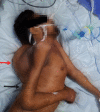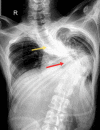Challenges in the Endotracheal Intubation of a Patient With Severe Spine Curvature Abnormality
- PMID: 34703695
- PMCID: PMC8530501
- DOI: 10.7759/cureus.18161
Challenges in the Endotracheal Intubation of a Patient With Severe Spine Curvature Abnormality
Abstract
Severe spine curvature disorders are commonly associated with multiple pathophysiological challenges during airway management, secondary to physiological and anatomical factors. These factors are mostly related to the reduced vital capacity and chest wall compliance, along with the misalignment of axes and limitation in neck movement. Careful assessment and planning of alternative strategies by experienced anesthesiologists, appropriate positioning, and proper use of rescue devices can significantly improve the chances of successful intubation. In this report, we present a case of a 26-year-old man with severe spine curvature abnormality, unstable vitals, low Glasgow Coma Scale (GCS) score, and low oxygen saturation necessitating emergency intubation. We shed light on the importance of proper airway assessment and good team communication and also highlight the technique used for emergency intubation in case of an anticipated difficult airway.
Keywords: anesthesiology; difficult airway; difficult intubation; emergency medicine; kyphosis; lordosis; scoliosis; spine curvature disorders; trachea.
Copyright © 2021, Javaid et al.
Conflict of interest statement
The authors have declared that no competing interests exist.
Figures



References
-
- Issac S, Das JM. StatPearls [Internet] Treasure Island, FL: StatPearls Publishing; 2021. Kyphoscoliosis. - PubMed
-
- Kyphoscoliosis and difficult airway management. Saraçoğlu KT, Baygın Ö, Kafalı İH. DBU Florence Nightingale J Med. 2015;1:43–47.
-
- Double-lumen tube for ventilation in severe kyphoscoliosis. Kundra P, Joseph A, Kumar S, Sai Chandran BV. J Anesth. 2008;22:317–321. - PubMed
Publication types
LinkOut - more resources
Full Text Sources
